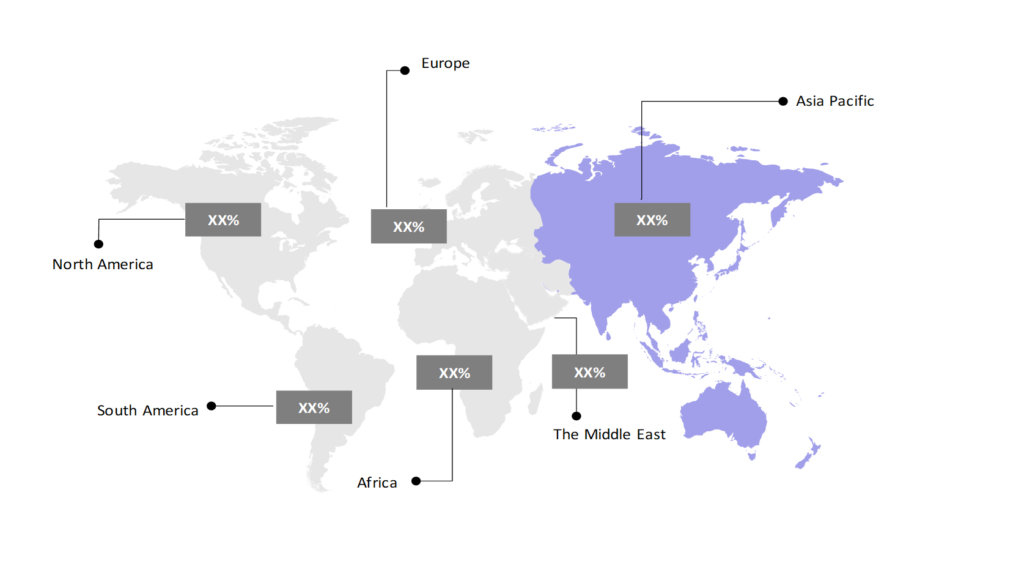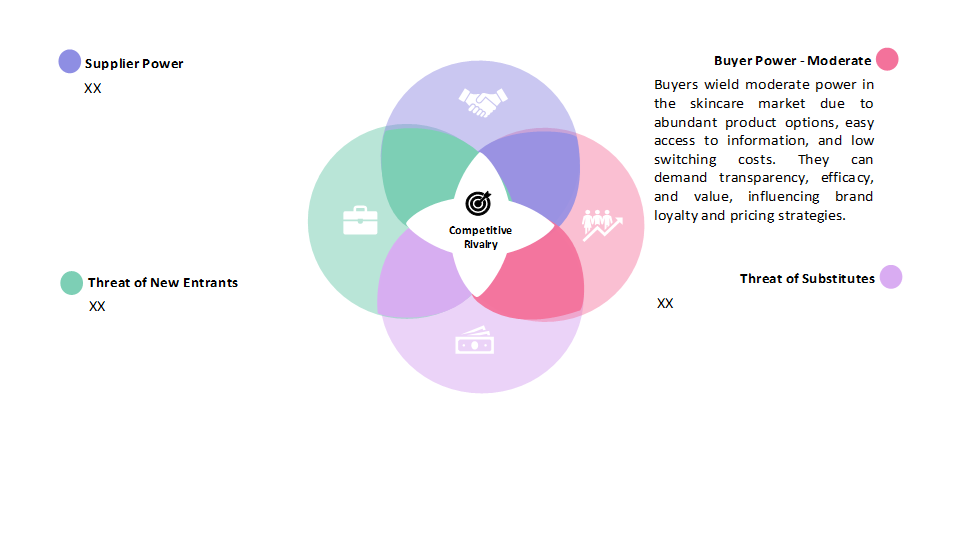Skincare Market Insights: Size, Share, Growth Analysis & Forecast (2024-2029)
The report covers a comprehensive analysis segmented by Product (Creams, Lotions, Powders, Sprays, Others), by Packaging Type (Tubes, Bottles, Jars, Others), by Gender (Men, Women), by Distribution Channel (Cosmetic Stores, Supermarkets/ Hypermarkets, Online, Others), By Geography (North America, South America, Asia Pacific, Europe, The Middle East, Africa).
Skincare Market Snapshot

Skincare Market Overview
The global skincare market is estimated to be at $152.33 Bn in 2024 and is anticipated to reach $190.24 Bn in 2029. The global skincare market is registering a CAGR of 4.54% during the forecast period 2024-2029. The skincare market is a thriving industry characterized by many factors, including evolving consumer preferences, technological advancements, and a growing emphasis on sustainability and wellness.
The growing understanding of the value of skincare practices for general health and wellness is one of the main factors propelling the expansion of the skincare industry. As consumers become more knowledgeable about the advantages of skincare products and practices, there is an increased need for solutions that target certain issues including aging, acne, hyperpigmentation, and environmental damage.
Moreover, the influence of social media platforms and digital marketing has transformed the way consumers discover, research, and purchase skincare products. Influencers and beauty bloggers play a significant role in shaping trends and driving product adoption, while e-commerce platforms provide convenient access to a wide range of products, further fueling market growth.
The growth of sustainable and clean beauty is another noteworthy development in the skincare industry. Customers are looking for formulas that are natural, organic, and sourced ethically as they become more aware of the components in the skincare products they use. The current trend towards clean beauty has given rise to independent firms that defy conventional industry rules by prioritizing sustainability, transparency, and cruelty-free procedures.
In addition, technological developments like smart gadgets, customized skincare products, and artificial intelligence are propelling innovation in the skincare industry. Companies are using data-driven insights to create customized skincare routines based on the requirements and preferences of each consumer, improving the effectiveness and usability of their products.
Despite the growth opportunities, the skincare market also faces challenges such as intense competition, regulatory complexities, and economic fluctuations. Brands must navigate these challenges by continuously innovating, differentiating themselves through product quality and branding, and adapting to changing consumer preferences and market dynamics. In summary, the skincare market is a dynamic and lucrative industry driven by factors such as evolving consumer trends, digital transformation, sustainability, and technological innovation. Brands that can effectively respond to these trends and challenges are poised for success in this competitive landscape.
Skincare Market Coverage
| Historical & Forecast Period | 2018-2029 |
| Base Year | 2023 |
| Forecast Period | 2024-2029 |
| Units | Billion US$ |
| Segments | Product, Packaging Type, Gender, Distribution Channel |
| Geographies | North America, South America, Asia Pacific, Europe, The Middle East, Africa |
| Key Vendors | Loreal, Unilever PLC, Johnson & Johnson, Coty Inc., Kao Group |
Key Geographies of Skincare Market, 2023

Porter’s 5 Forces Analysis of Skincare Market

Skincare Market Trends
Recent years have seen a considerable expansion and change of the skincare industry, driven by a number of causes such as growing disposable income, growing health consciousness, and technological breakthroughs in the field.
One prominent trend is the shift towards natural and organic skincare products, as consumers become more conscious of ingredients and their impact on health and the environment. Additionally, there’s a growing demand for personalized skincare solutions, driven by the desire for products tailored to individual skin types and concerns. For example, The Ordinary, a brand under the Deciem umbrella, gained popularity for its transparent approach to skincare, offering simple formulations with high-quality active ingredients at affordable prices. The brand’s emphasis on transparency and efficacy resonated with consumers seeking skincare products without unnecessary additives or harsh chemicals. The Ordinary’s minimalist approach to packaging and marketing also aligns with the growing consumer preference for sustainable and eco-friendly products.
The incorporation of technology into skincare is another noteworthy trend, as evidenced by the emergence of advanced gadgets like LED masks, facial cleansing brushes, and smart skincare equipment. These innovations serve tech-savvy customers by providing better skincare experiences and outcomes. For instance, the Sonic Thermo Facial Brush was introduced by the beauty tech business Geske in March 2024. It’s a cleanser, heated brush, and facial massager all rolled into one, designed to fit comfortably into the hand and perfectly align with facial contours. It promises natural, brighter, and rejuvenated skin through a variety of impressive features.
Moreover, the skincare market is witnessing a surge in demand for anti-aging products, driven by aging populations globally and the desire for youthful-looking skin. This has led to the development of advanced formulations and ingredients targeting specific signs of aging, such as wrinkles, fine lines, and age spots.
Overall, the skincare market is dynamic and competitive, with continuous innovation and an emphasis on holistic skincare solutions driving growth and shaping consumer preferences.
Skincare Market Driving Factors
A driver analysis of the skincare market reveals several key factors shaping its growth and dynamics. Increasing consumer awareness of skincare health and the desire for youthful, radiant skin are significant drivers. As people become more informed about skincare ingredients and their benefits, they seek products that address specific concerns such as aging, acne, or sensitivity.
Moreover, rising disposable incomes, particularly in emerging markets, contribute to the growth of the skincare market. With higher purchasing power, consumers are willing to invest in premium skincare products and treatments to achieve desired results. One notable example is the success of luxury skincare brands like SK-II in the Chinese market. SK-II, known for its high-quality skincare products and innovative ingredients like Pitera, has seen significant growth in China due to increasing demand from affluent consumers.
Another driver is the influence of social media and beauty influencers, which play a crucial role in shaping consumer preferences and driving product demand. Social media platforms serve as powerful marketing channels for skincare brands, allowing them to reach a wider audience and engage with consumers directly. For instance, Korean skincare brand Glow Recipe gained significant traction through the strategic use of social media platforms like Instagram and YouTube, leveraging partnerships with beauty influencers to showcase their products to a global audience. Influencers, such as beauty vloggers and skincare enthusiasts, often create engaging content featuring Glow Recipe’s innovative products, such as their Watermelon Glow Sleeping Mask and Pineapple-C Bright Serum.
Furthermore, technological developments in skincare spur market innovation and product development. Technological innovations allow skincare firms to provide consumers with more targeted and effective solutions, from advanced gadgets to innovative chemicals.
Lastly, demographic shifts, such as aging populations and increasing urbanization, also impact the skincare market. Aging populations drive demand for anti-aging products, while urbanization leads to higher pollution levels and a greater need for skincare products that protect against environmental damage.
Overall, these drivers collectively contribute to the growth and evolution of the skincare market, shaping consumer behavior and market dynamics.
Skincare Market Challenges
The skincare market is a dynamic industry characterized by evolving consumer preferences, technological advancements, and a surge in demand for natural and sustainable products. Challenges within this sector include fierce competition among established brands and emerging startups, regulatory hurdles related to ingredient safety and product claims, and the impact of economic fluctuations on consumer spending.
Meeting the varied needs of customers across different demographics, such as age, gender, and skin type, is one major difficulty. To address certain issues like aging, acne, sensitivity, and environmental damage, this calls for constant innovation in product development and marketing methods.
Additionally, the rise of social media influencers and online beauty communities has transformed the way consumers discover, research, and purchase skincare products, posing both opportunities and challenges for brands to effectively engage with their target audience.
Moreover, sustainability and ethical sourcing have become increasingly important considerations for consumers, driving demand for eco-friendly packaging, cruelty-free formulations, and transparency in supply chains.
Overall, success in the skincare market requires brands to adapt to changing consumer preferences, leverage technology for product innovation and marketing, navigate regulatory complexities, and demonstrate a commitment to sustainability and ethical practices.
Skincare Market – Key Industry News
- In May 2024, Bubble Skincare collaborated with Disney. The program consists of limited-edition Bubble Skincare product packages, including Day Dream, Tone and Texture Serum, Fresh Start Gel Cleanser, and Slam Dunk Hydrating Cream Moisturizer. By collaborating with Disney, particularly on Inside Out 2, Bubble Skincare is reaching a large audience that enjoys both Disney’s well-known characters and narratives in addition to skincare.
- Elevai Labs, Inc., a medical aesthetics company, announced in May 2024 the creation of Elevai Biosciences, Inc. and Elevai Skincare, Inc. as two new wholly-owned subsidiaries. These initiatives represent a strategic turn toward the creation of cutting-edge cosmetic medications and initiatives to strengthen the financial position of its well-known exosome skincare brand.
- CycloRetin, a natural skincare active, was introduced by Clariant in March 2024 in Paris. CycloRetin is a naturally mild retinoid that activates its benefits.
Skincare Market Competitive Landscape
The skincare market boasts a highly competitive landscape characterized by a mix of established multinational corporations and innovative indie brands. Major players like Loreal, Unilever PLC, Johnson & Johnson, Coty Inc., Kao Corp., and others dominate with extensive product portfolios, global distribution networks, and significant marketing budgets. These companies leverage economies of scale to invest in research, marketing, and acquisitions, maintaining their market leadership.
Simultaneously, the rise of indie beauty brands like The Ordinary, Glossier, and Drunk Elephant has disrupted the market with unique formulations, direct-to-consumer models, and authentic brand narratives. These brands capitalize on consumer demand for transparency, efficacy, and sustainability, carving out niche segments and challenging traditional industry norms.
Moreover, the skincare market is witnessing increased competition from niche players specializing in clean beauty, natural ingredients, and personalized skincare solutions. These brands differentiate themselves through innovative formulations, targeted marketing, and community-building strategies, catering to specific consumer preferences and driving further fragmentation in the market. Overall, the skincare market’s competitive landscape is characterized by a balance between established giants, nimble challengers, and niche innovators vying for consumer attention and market share.
Skincare Market Company Share Analysis, 2023 (%)

Skincare Market – Key Companies

Reason to Buy from us

Table of Contents
| 1. Introduction |
|---|
| 1.1. Research Methodology |
| 1.2. Scope of the Study |
| 2. Market Overview / Executive Summary |
| 2.1. Global Skincare Market (2018 – 2022) |
| 2.2. Global Skincare Market (2023 – 2029) |
| 3. Market Segmentation |
| 3.1. Global Skincare Market by Product |
| 3.1.1. Creams |
| 3.1.2. Lotions |
| 3.1.3. Powders |
| 3.1.4. Sprays |
| 3.1.5. Others |
| 3.2. Global Skincare Market by Packaging Type |
| 3.2.1. Tube |
| 3.2.2. Bottles |
| 3.2.3. Jar |
| 3.2.4. Others |
| 3.3. Global Skincare Market by Gender |
| 3.3.1. Men |
| 3.3.2. Women |
| 3.4. Global Skincare Market by Distribution Channel |
| 3.4.1. Cosmetic Stores |
| 3.4.2. Supermarkets/Hypermarkets |
| 3.4.3. Online |
| 3.4.4. Others |
| 4. Regional Segmentation |
| 4.1. North America |
| 4.1.1. The U.S |
| 4.1.2. Canada |
| 4.1.3. Mexico |
| 4.2. South America |
| 4.2.1. Brazil |
| 4.2.2. Argentina |
| 4.2.3. Colombia |
| 4.2.4. Chile |
| 4.2.5. Rest of South America |
| 4.3. Asia Pacific |
| 4.3.1. China |
| 4.3.2. India |
| 4.3.3. Japan |
| 4.3.4. South Korea |
| 4.3.5. Rest of Asia Pacific |
| 4.4. Europe |
| 4.4.1. UK |
| 4.4.2. Germany |
| 4.4.3. Italy |
| 4.4.4. France |
| 4.4.5. Spain |
| 4.4.6. Rest of Europe |
| 4.5. The Middle East |
| 4.5.1. Turkey |
| 4.5.2. UAE |
| 4.5.3. Saudi Arabia |
| 4.5.4. Rest of the Middle East |
| 4.6. Africa |
| 4.6.1. Egypt |
| 4.6.2. South Africa |
| 4.6.3. Rest of Africa |
| 5. Value Chain Analysis of the Global Skincare Market |
| 6. Porter Five Forces Analysis |
| 6.1. Threats of New Entrants |
| 6.2. Threats of Substitutes |
| 6.3. Bargaining Power of Buyers |
| 6.4. Bargaining Power of Suppliers |
| 6.5. Competition in the Industry |
| 7. Trends, Drivers and Challenges Analysis |
| 7.1. Market Trends |
| 7.1.1. Market Trend 1 |
| 7.1.2. Market Trend 2 |
| 7.1.3. Market Trend 3 |
| 7.2. Market Drivers |
| 7.2.1. Market Driver 1 |
| 7.2.2. Market Driver 2 |
| 7.2.3. Market Driver 3 |
| 7.3. Market Challenges |
| 7.3.1. Market Challenge 1 |
| 7.3.2. Market Challenge 2 |
| 7.3.3. Market Challenge 3 |
| 8. Regulatory Landscape |
| 9. Competitive Landscape |
| 9.1. Loreal |
| 9.2. Unilever PLC |
| 9.3. Johnson & Johnson |
| 9.4. Coty Inc. |
| 9.5. Kao Group |
| 9.6. Company 6 |
| 9.7. Company 7 |
| 9.8. Company 8 |
| 9.9. Company 9 |
| 9.10. Company 10 |
Skincare Market – Frequently Asked Questions (FAQs)
What is the current size of the global Skincare market?
The market size for the global Skincare market in 2024 is $152.33 Bn.
Who are the major vendors in the global Skincare market?
The major vendors in the global Skincare market are Loreal, Unilever PLC, Johnson & Johnson, Coty Inc., Kao Group.
Which segments are covered under the global Skincare market segments analysis?
This report offers in-depth insights into each product, packaging type, gender, distribution channel.
